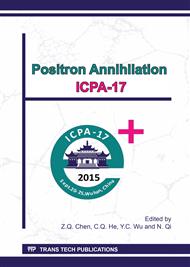[1]
H. Saito and T. Hyodo, Experimental evidence for spin-orbit interactions in positronium-Xe collisions, Phys. Rev. Lett. 97 (2006) 253402.
DOI: 10.1103/physrevlett.97.253402
Google Scholar
[2]
J. Mitroy and S. A. Novikov, Spin-orbit quenching of positronium during atomic collisions, Phys. Rev. Lett. 90 (2003) 183202.
DOI: 10.1103/physrevlett.90.183202
Google Scholar
[3]
K. Shibuya, T. Nakayama, H. Saito, and T. Hyodo, Spin conversion and pick-off annihilation of ortho-positronium in gaseous xenon at elevated temperatures, Phys. Rev. A 88 (2013) 012511.
DOI: 10.1103/physreva.88.012511
Google Scholar
[4]
R. S. Vallery, A. E. Leanhardt, M. Skalsey, and D. W. Gidley, Temperature dependence of positronium decay rates in gases, J. Phys. B 33 (2000) 1047.
DOI: 10.1088/0953-4075/33/5/318
Google Scholar
[5]
S. J. Buckman and J. Mitroy, Analysis of low-energy electron scattering cross section via effective-range theory, J. Phys. B 22 (1989) 1365.
DOI: 10.1088/0953-4075/22/9/010
Google Scholar
[6]
M. Kitajima, M. Kurokawa, T. Kishino, K. Toyoshima, T. Odagiri, H. Kato, K. Anzai, M. Hoshino, H. Tanaka, and K. Ito, Eur. Phys. J. D 66 (2012) 130.
DOI: 10.1140/epjd/e2012-20629-0
Google Scholar
[7]
K. Shibuya, Y. Kawamura, and H. Saito, Time-resolved determination of ortho-positronium kinetic energy utilizing p-wave scattering during positronium-xenon collisions, Phys. Rev. A 88 (2013) 042517.
DOI: 10.1103/physreva.88.042517
Google Scholar
[8]
L. Sarkadi, Fragmentation of positronium in collision with He atoms: A classical theoretical approach, Phys. Rev. A 68 (2003) 032706.
DOI: 10.1103/physreva.68.032706
Google Scholar
[9]
S. J. Brawley, A. I. Williams, M. Shipman, and G. Laricchia, Resonant Scattering of Positronium in Collision with CO2, Phys. Rev. Lett. 105 (2010) 263401.
DOI: 10.1103/physrevlett.105.263401
Google Scholar


